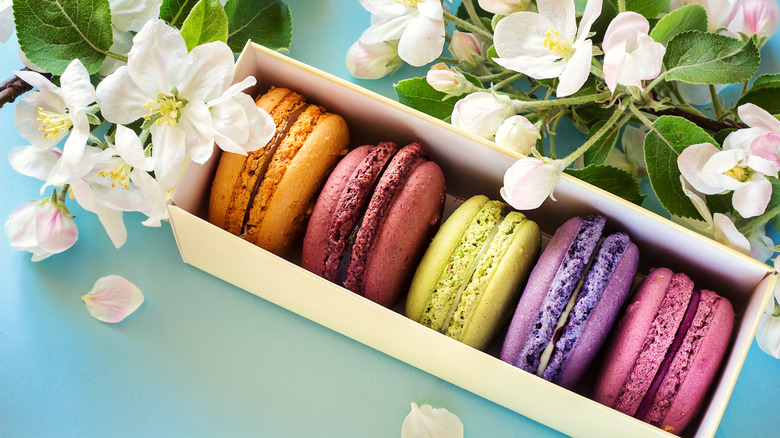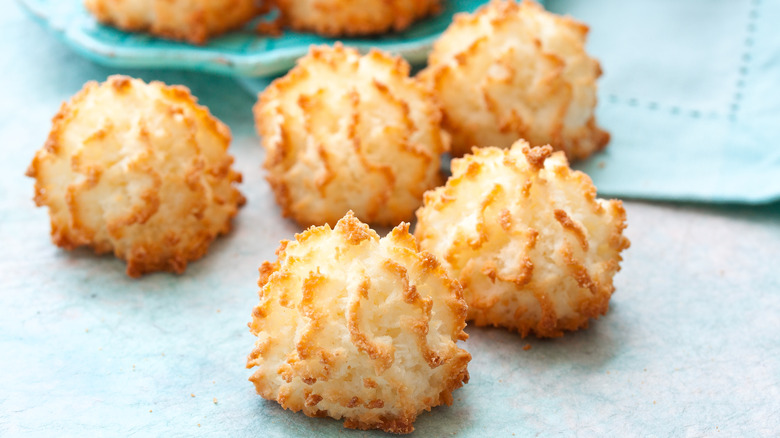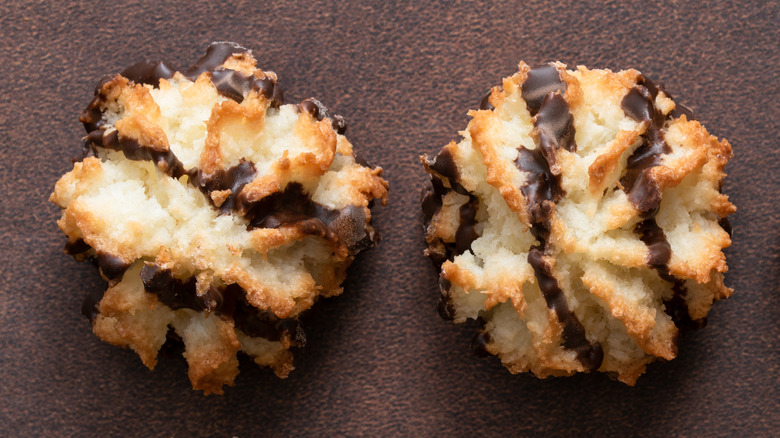The Difference Between Macarons And Macaroons
Sometimes you think you know something about food, and when you dig deeper into the topic, you discover you're not as knowledgeable as you thought. Experienced bakers (or even just experienced fans of cooking shows) might see the title of this article, and think "I got this, macarons and macaroons are completely different!" Fans of fancy bakes might fuss over foot formation and fret over fillings for macarons while turning up their noses at a basic drop cookie, one that's often mass-produced and bought in a tin.
And yes, macarons and macaroons are different. But they have more in common than you might think. As so many things are, the evolutions of macarons and macaroons were shaped by place, time, and circumstances. Whether you're salivating over elegant confections in a patisserie or remembering the presence of a modest cookie at an annual holiday observance, macarons and macaroons are cookie siblings. They also share an origin story, though their paths have diverged over time and distance.
What's a macaron?
Preppy Kitchen explains that a macaron is an elegant sandwich cookie, made of almond flour folded into meringue, which is piped onto a baking sheet, rested to develop a skin on the smooth surface of the cookies, baked, and then two cookie disks are sandwiched together with a filling of jam, buttercream, or ganache. They're airy and melt-in-your-mouth delicate. The popularity of macarons has exploded over the past few years and so have attempts at making the pastry, per Ventured.
Home cooks may anxiously check the humidity to pick the best day for baking since Gemma's Bigger Bolder Baking points out that high humidity is no friend to the finicky macaron. Shortcut chefs who skip the almond flour-sifting step may discover their macarons lack the polished exterior that makes the macaron so elegant. Making macarons is a chore, so folks who don't feel like fussing with the temperamental macaron may opt to shell out a pretty penny to acquire store-bought treats, as Ventured notes a single French macaron costs more than $3. Macarons are luxe, Insta-worthy, and the poshest of desserts, and Tasting Table readers have revealed their favorite flavors are classics — chocolate and vanilla.
What's a macaroon?
A macaroon, by contrast, is a fairly simple drop cookie, according to Ina Garten's recipe from Food Network. Its ingredients are pretty basic — just shredded coconut, sweetened condensed milk, vanilla (the good stuff, of course), egg whites, and a little salt. While the recipe does call for beating the egg whites and folding them into your other ingredients, macaroons are pretty foolproof. As long as you don't forget them in the oven, they'll turn out just fine. They're a far cry from fiddly macarons.
Macaroons are historically served for Passover, according to The Nosher, though they don't have a historic or symbolic significance, as do many components of a traditional seder. One of the reasons macaroons typically appear — either store-bought or homemade — for Passover is they don't contain wheat flour. There's only one food containing flour that's permissible for Passover, according to OU Kosher, and that's matzah, unleavened bread made of flour and water and certified kosher by one of the organizations that regulate such matters. Macaroons are the perfect Passover dessert since they don't contain flour, which is why Mira Fox, a reporter for the Forward, determined via a poll on social media that macaroons are "an iconic part of Passover for North American Jews," regardless of whether or not they actually like the taste.
So how are macarons and macaroons related?
Danny Macaroons relates the story of the origins of macarons and macaroons, and it turns out, they're the same story. The cookies' forbears date back more than 1,000 years, to the Arab empire that expanded into what we now know as Sicily. One of the foods that traveled with these settlers was a cookie made of ground nuts and honey. The word the Italians used to describe the cookie was "maccheroni," meaning something ground. Egg whites were added to the mixture, and that cookie still exists in Italy, called the amaretti.
Catherine de Medici is credited with bringing the maccheroni cookies with her when she left Italy for France in the 1500s, where the name was transformed into the French macaron. In France, fillings were added between layers of macaron cookies in the early 1900s. When the cookies landed in the U.S. in 1894, they were transformed by a flour miller named Franklin Baker, who had received a huge shipment of coconut from Cuba as payment.
With a mountain of coconuts that he didn't want to spoil, Baker shredded, dried, and sold the coconut to home cooks. Coconut made macaroons less fragile than the almond flour traditionally used, and the less-francophile version of the cookie evolved into its own in the U.S. So while macarons and macaroons are, indeed, different cookies altogether, they're sweet sisters, separated after birth and raised on different continents, reflecting the cultures that shaped them.



